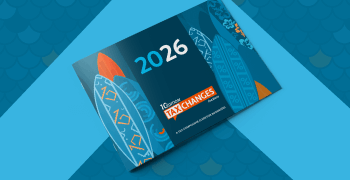
HS codes: Why accuracy matters more than ever in the AI age
Market volatility, supply chain disruption, and even global conflict can affect overseas trade. But it’s actually just a few digits that are most likely to make or break your cross-border operations: Harmonised System (HS) codes. These identifiers are an integral part of global customs classification. Assigned to every product sold across international borders, they enable customs authorities to calculate the correct duties and taxes. Applying codes accurately to your goods helps to ensure they move as smoothly as possible through customs, saving you time and money.
Two shifts in the international trade landscape mean HS codes have taken on a new significance for European businesses selling into the U.S.: The removal of the U.S. de minimis, meaning even low-value parcels are now subject to duties and customs checks, and the emergence of AI-powered customs enforcement that’s helping authorities detect misclassified goods and inconsistencies in data.
Together, these developments mean one thing: HS code accuracy is more important than ever.
Key takeaways
- Every shipment now counts — The removal of the U.S. de minimis threshold means even the smallest parcels are subject to full customs scrutiny.
- AI is raising the bar for compliance — Customs authorities are using artificial intelligence to detect misclassifications faster than ever. Errors that once slipped through unnoticed are now instantly flagged.
- Fight AI with AI — Businesses can stay ahead by using AI-powered classification tools to automate HS code assignment.
The big change: The end of easy entry
Until recently, most low-value shipments sent to U.S. customers benefited from the de minimis rule. Goods valued below $800 could typically enter the country duty-free with minimal paperwork — a system that supported the increase in cross-border ecommerce between Europe and the U.S.
That safety net has gone. On 29 August 2025, the U.S. removed its de minimis threshold, bringing all imports — regardless of value — into the full customs regime. This means every shipment now requires a complete and accurate declaration, including the 10-digit Harmonized Tariff Schedule of the United States (HTSUS) code.
When low-value shipments were exempt, classification errors rarely drew attention. A €30 T-shirt now faces the same customs scrutiny as a €3,000 shipment of designer apparel.
AI is changing how customs work
The other major shift is technological. Imagine a customs officer supported by an AI assistant that can instantly check millions of product descriptions and historical classifications, identify patterns, and flag inconsistencies. That’s the reality today, thanks to initiatives like the World Customs Organization’s BACUDA project. It’s part of the WCO’s effort to help customs administrations around the world harness the power of AI so they can detect irregularities, improve targeting, and automate routine classification.
Similarly, U.S. Customs and Border Protection (CBP) and the European Commission’s TAXUD directorate are investing heavily in data analytics to automate classification checks and risk profiling.
In practice, this means that AI can cross-check your product description, value, and country of origin against global trade data. If the system spots a mismatch — for example, a “cotton shirt” classified under a code for “synthetic apparel” — it can flag your shipment instantly. The result is compliance mistakes that once went unnoticed can now be identified automatically and at scale.
The new compliance reality for European exporters
For European businesses selling into the U.S., the removal of de minimis and rise of AI enforcement combine to create a new level of compliance exposure. Every shipment — large or small — now requires complete, accurate customs data. That means the correct HS/HTSUS code, declared value, and country of origin.
With AI-assisted enforcement, discrepancies that once slipped through unnoticed are now instantly flagged. A single incorrect code can trigger penalties or delay delivery, which, in the era of next-day ecommerce expectations, can damage your reputation.
The risk of fines or seizure of goods from undeclared duties or misclassifications is now higher than ever, making classification accuracy a competitive factor.
Your HS codes determine much more than the duty rate. They define how your goods are treated by customs systems worldwide — including import controls, safety standards, and eligibility for preferential tariffs. Errors can result in overpaying or underpaying duties, leading to financial loss or audit risk. Your goods could even be seized at customs or returned to you at cost.
HS codes are also used to determine eligibility for preferential duty rates under free trade agreements such as USMCA and the EU’s various agreements. A misclassified product could mean you miss out on duty savings, or it could lead to noncompliance with origin rules.
The role of AI in classification: in the armoury on both sides
As customs authorities use AI to check HS codes with greater scrutiny, businesses can use AI-powered classification tools to improve their HS code accuracy. These solutions use automation to assign the correct codes to products, maintain consistency, and document every decision. While AI may be the death knell for spreadsheets and manual processes in item classification, it can also be used to help you with:
- Scalability — Handle thousands of stock keeping units (SKUs) across multiple markets without manual bottlenecks.
- Speed — Process product catalogues in seconds using machine-learning models trained on millions of past classifications.
- Consistency — Apply the same logic across all business units and regions.
- Confidence scoring — Flag uncertain classifications for human review before filing.
- Audit readiness — Generate an automated trail showing why each HS or HTSUS code was chosen.
- Faster clearance — Reduce the chance of customs holdups, helping you meet delivery promises and maintain customer satisfaction.
- Predictable landed costs — Get more accurate pricing and better margin planning.
- Reduced audit risk — Reduce the likelihood of costly investigations with a consistent, well-documented classification process.
AI-driven HS code accuracy could well prove to be a defining factor for the success of European businesses exporting to the U.S. and elsewhere around the globe. Turning compliance accuracy into a strength can help businesses trade with greater speed, transparency, and confidence, and stay ahead of their competition.
By using automation intelligently, you can ensure that every shipment you send is correctly classified, quickly cleared, and fully compliant.
How to stay ahead in the AI age
As customs authorities use AI to check HS codes, you can stay one step ahead with Avalara cross-border solutions. Our intelligent automation and AI-powered classification tools help you assign the right HS codes, calculate duties and taxes accurately, and keep shipments moving without unnecessary delays. Speak with Avalara today.
FAQ
What exactly is an HS code and why is it important?
A Harmonised System (HS) code is a globally standardised classification number assigned to traded products. Customs authorities use these codes to identify goods, calculate duties and taxes, and apply relevant import controls. Accurate HS codes ensure shipments move smoothly through customs and help businesses avoid delays, fines, or overpaid duties.
How does AI help customs authorities check HS codes?
AI and machine learning allow customs authorities to process vast amounts of trade data quickly and identify inconsistencies in declarations. Tools like the World Customs Organization’s BACUDA project use AI to automatically suggest HS codes and flag irregularities — meaning misclassified goods can now be detected more efficiently than ever before.
What happens if I use the wrong HS code when exporting to the U.S.?
An incorrect HS code can lead to the wrong duty rate being applied, delays at customs, or even seizure of goods. Repeated misclassifications may trigger audits or penalties. With the removal of the de minimis threshold, every shipment — no matter how small — must now have accurate classification to avoid compliance risks.
How can my business improve HS code accuracy?
Start by ensuring your product data (materials, use, composition) is complete and up to date. Then, consider using AI-powered classification tools that automatically assign HS and HTSUS codes, flag potential errors, and create an audit trail for compliance. Pairing automation with expert oversight helps you maintain accuracy and stay compliant as rules and technologies evolve.

Avalara Tax Changes 2026 is here
The 10th edition of our annual report engagingly breaks down key policies related to sales tax, tariffs, and VAT.
Stay up to date
Sign up today for our free newsletter and receive the latest indirect tax updates impacting businesses selling internationally straight to your inbox.



